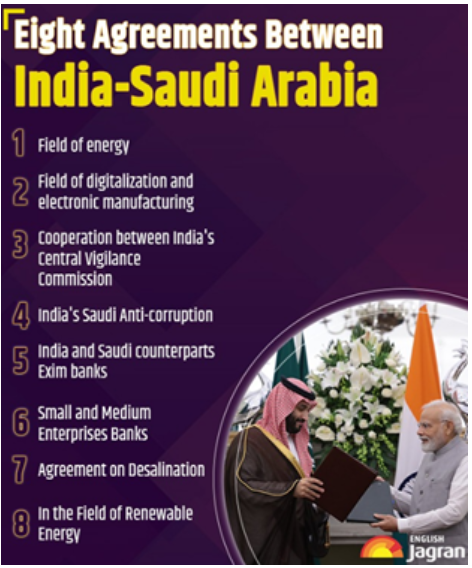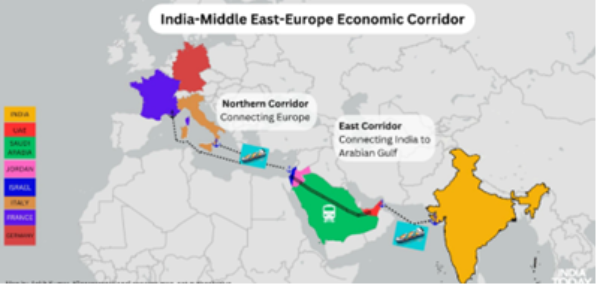Tuesday, 19th September 2023
Paris agenda for the people and the planet
In News: After the G20 meet, it is clear that world leaders are serious about delivering on the Paris Agenda and “One Earth, One Family, One Future.”
About the Paris agenda for the people and the planet:
- At the end of June, a historic summit on international solidarity concluded the Paris Agenda for People and the Planet.
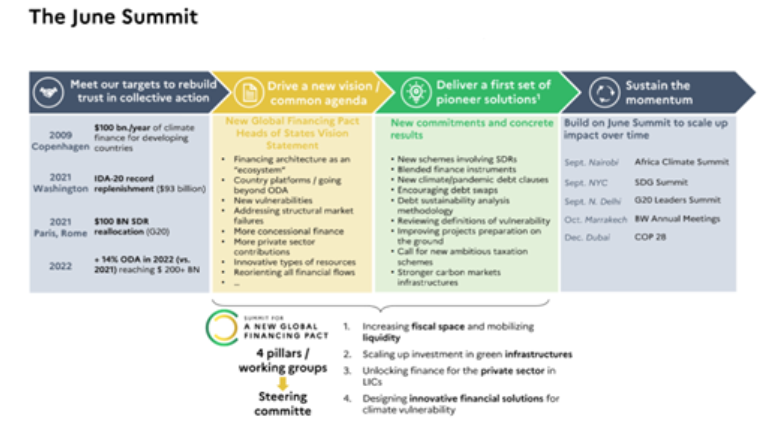
- African leaders amplified this dynamic by adopting the Nairobi Declaration during the first Africa Climate Summit in Kenya.
- The G20 summit in New Delhi, pushed this agenda forward with the New Delhi Declaration.
What are the principles that must guide the actions to fulfil the Paris agenda?
- No country should have to choose between fighting poverty and fighting to protect and preserve the planet.
- Facing different needs, countries may need to pursue diverse transition paths while coming together to meet the goals of the 2015 Paris climate agreement.
- This is why the Just Energy Transition Partnerships and Country Packages for Forest, Climate and Nature is being accelerated.
- More financial resources are needed to support vulnerable economies, lifting their populations out of poverty while protecting the planet.
- Meeting today’s global challenges will depend on scaling up the use of private capital flows to emerging and developing economies.
- The target of $100 billion worth of special drawing rights or equivalent contributions has already been achieved, to be channelled to the world’s most vulnerable countries, especially in Africa.
- Each dollar of lending by multilateral development banks (MDBs) should be complemented by at least one dollar of private finance.
- An overall increase of $200 billion in MDBs’ lending capacity over the next ten years is possible by optimising their balance sheets and enabling them to take more risks.
- There is a need for more efficiency in using this capital.
What is the way forward to achieve the Paris agenda?
- Improving the timeliness and predictability of the debt restructuring coordination mechanism for low-income countries (the G20’s Common Framework for Debt Treatments) and extending it to lower-middle-income countries.
- Accelerating debt suspension when needed, including to increase fiscal space for countries that are in debt distress.
- The Common Framework has already been delivered for Chad and Zambia and it can and must be used on a larger scale.
- Countries must support each other when one is hit by a disaster.
- That calls for specific tools to strengthen their resilience, including a climate-crisis clause in debt contracts.
- All financial institutions and actors will need to work together to fulfil it.
- Part of this cooperative effort must involve coordinating the MDBs and public development banks in the ‘Finance in Common’ global network of development banks.
- Cooperation on the energy transition can be achieved through the Climate Club, which the G7 established in order to fulfil the Paris climate agreement.
- New avenues for international taxation will also need to be found in order to meet our climate commitments.
- Governments will need to clamp down on financial flows that escape legitimate tax systems.
- Developing countries will need fair partnerships that enable them to generate added value by processing raw materials and critical minerals locally, and that reinforce the commitment to strengthen health-care and food infrastructure.
- An ambitious financial replenishment of the International Development Association, a deepening of the IMF’s Poverty Reduction and Growth Facility, and increased funding for the World Bank and IMF’s other concessional facilities could also play a big part in helping the world’s poorest countries.
- Including climate vulnerability in the World Bank and IMF’s mission will enable more investment in projects that assist poor countries in combating climate change.
UPI-PM WANI: India's Digital Transformation
Why in News: PM-WANI presents a golden opportunity to accelerate high-speed unlimited internet penetration, bridging the digital divide and empowering communities nationwide.
Prime Minister’s Wi-Fi Access Network Interface (PM-WANI):
- The concept of WANI was first proposed by the Telecom Regulatory Authority of India (TRAI) in 2017.
- WANI envisions creating millions of interoperable Wi-Fi hotspots or Public Data Offices (PDOs).
- These PDOs would cater to the last-mile distribution of broadband internet to the common people in affordable sachet-sized packages.
Significance of PM-WANI:
- Currently, India’s home broadband penetration is one of the lowest in the world. PM-WANI presents a golden opportunity to accelerate high-speed unlimited internet penetration, bridging the digital divide and empowering communities nationwide.
- It presents a unique approach to internet distribution at the last mile, promoting affordability and accessibility.
- By eliminating additional licensing fees, the initiative encourages more players to participate in providing Wi-Fi hotspots, thereby ensuring greater coverage and reach.
- It can lead to an exponential increase in the number of individuals with internet access, especially in underserved areas.
Sachet Internet:
- The introduction of sachet-sized internet packages priced at Rs 5 to 10 has been a game-changer in promoting internet usage among the masses.
- For students, in particular, these affordable plans have become a preferable alternative to purchasing other consumables like chips or soft drinks from their pocket money.
- The availability of sachet internet plans has democratized access to information and educational resources, making it easier for individuals from all walks of life to harness the power of the internet for learning and personal growth.
Challenges:
- One common argument against the initiative is that data is already cheap, and nearly everyone has access to 4G connectivity. However, this oversimplification overlooks the fact that affordability and access remain significant issues, particularly in economically disadvantaged and rural regions.
- Some existing platforms like Aadhaar, Aarogya Setu, CoWIN, and Government E-Marketplace (GEM) lack a legal mandate defining their functions, roles, and responsibilities, which raises concerns about data collection and potential breaches of personal information.
Way Forward:
- All stakeholders, including governments, civil society, and start-ups, must actively promote and support the initiative.
- Its potential to bridge the digital divide and empower communities through enhanced internet access is significant and should not be underestimated.
- PM-WANI's unique approach to interoperability, openness, and scalability in Digital Public Infrastructure (DPI) has the potential to make it as successful as UPI and other Digital Public Infrastructures (DPIs).
Parliamentary conduct - Edukemy Current Affairs
Why in News: The members of India's Parliament frequently cause disturbances, which is characterised by their propensity for disruption over discussion. This undermines the efficacy and credibility of the legislative body and raises questions about the democracy in India.
Indian Parliament:
- The Parliament of India is the top legislative body of the Union government.
- Due to the adoption of the Parliamentary form of Government (often known as the "Westminster" model of government), it holds a dominant and important role in the Indian democratic political system.
- Part V of the Constitution deals with the organisation, membership, length, officials, processes, privileges, and powers of the Parliament in Articles 79 to 122.
- The Lower House (Lok Sabha), the Upper House (Rajya Sabha) and the President are the organs of the Indian Parliament.
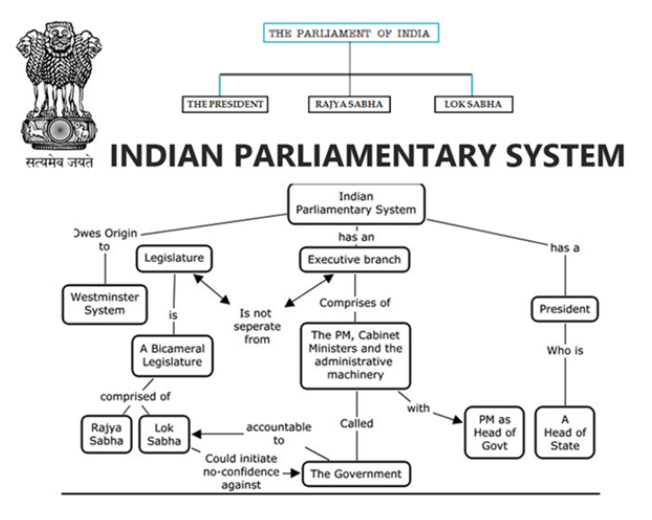 Issues in the Indian Parliament:
Issues in the Indian Parliament:
- Frequent Disruptions: Instead of participating in productive debates, MPs engage in disruptive activity.
- Declining Standards: Legislators frequently violate the rule of conduct, and parliamentary misbehaviour has become worse over time.
- Impunity: There is a culture of impunity among legislators since their violations of the law frequently go unpunished.
- Credibility Concerns: Disruptive behaviour may have damaged Parliament's legitimacy in the eyes of the people.
- Inadequate Opposition Influence: Due to party-line voting and the anti-defection rule, opposition MPs have difficulty in influencing legislative decisions. While interruptions are accepted in order to give the opposition room, moral standards have been lowered.
- Role of Speaker: Opposition representation is hampered by the Speaker's denial of adjournment motions, amendments, and division votes.
- Potential Damage to Democracy: The legitimacy of India's democracy might be damaged by frequent disruptions and deteriorating quality.
Probable Solutions for the issues:
- Through seminars and training, create a culture of productive discourse.
- Senior lawmakers should lead by example by maintaining the highest ethical standards during discussions and debates.
- Make sure that repercussions for wrongdoing are consistently applied, irrespective of party affiliation.
- Transparency, responsibility, and respect for legislative procedures will help to rebuild public trust.
- Establish consistent Prime Minister's Question Time (PMQs) to promote conversation and accountability.
- Granting the opposition access to establish the debate's agenda on a specific day each week.
- Enable spirited debates and guarantee the Speaker's judgments are unbiased.
- Put democratic principles and ideals first in order to win back the public's trust in the Parliament.
‘Anti-trust’ Law - Edukemy Current Affairs
In News: Recently, Google faced allegations in a U.S. court that it used illegal tactics to maintain a monopoly in an online search.
About
- Antitrust laws are regulations that encourage competition by limiting the market power of any particular firm. This often involves ensuring that mergers and acquisitions don’t overly concentrate market power or form monopolies, as well as breaking up firms that have become monopolies.
- Antitrust laws also prevent multiple firms from colluding or forming a cartel to limit competition through practices such as price fixing. Due to the complexity of deciding what practices will limit competition, antitrust law has become a distinct legal specialization.
- The Sherman Act, the Federal Trade Commission Act, and the Clayton Act are the three pivotal laws in the history of antitrust regulation.

Unified Portal for Agricultural Statistics
In News: Recently, the Unified Portal for Agricultural Statistics was officially launched by the central government.
About
- Unified Portal for Agricultural Statisticsplatform is designed to revolutionize data management in India’s agriculture sector, addressing complex governance challenges.
- The UPAg Portal addres ses key challenges in agriculture data, including lack of standardization, verification, dispersion, and different update frequencies.
- It offers data standardization, advanced analytics, granular production estimates, commodity profile reports, and flexibility for users to prepare their own reports.
- The UPAg Portal is part of the Digital Public Infrastructure for Agriculture, focusing on harnessing data for growth, transparency, and agility in India’s agriculture sector.
- This initiative aligns with e-governance principles and aims to enhance data-driven decision-making for policymakers, researchers, and stakeholders in the agriculture domain.
Segur elephant corridor - Edukemy Current Affairs
In News: Recently, a Supreme Court-appointed committee has declared 12 private resorts along the Segur elephant corridor illegal.
About rSegur elephant corridor is vital for the movement of elephants and other wildlife between habitats in the Nilgiri Biosphere Reserve.
- The Sigur Elephant Corridor, the only one of its kind connecting Western and the Eastern Ghats and facilitating easy movement of about 6,300 Asiatic elephants from Kerala, Tamil Nadu, and Karnataka.
- Corridor causes displacement of over 12,000 people is facing stiff resistance from rights activists and agencies supporting indigenous communities as the project lack provisions for co-existence and community-based forest management.
- The corridor will connect Nagarhole, Bandipur, Wayanad, Mudumalai, Nilgiri North, B.R. Hills, and Sathyamangalam forest areas spread in Kerala, Tamil Nadu, and Karnataka.

Anamudi Shola national park - Edukemy Current Affairs
In News: The Munnar Wildlife Division in Idukki, India, has achieved a remarkable transformation of the Pazhathottam area within the Anamudi Shola National Park.
About
- Pazhathottam area was once a scorched landscape, dominated by exotic tree species, has been rejuvenated into a lush 50-hectare forest through a successful eco-restoration project.
- It is supported by the United Nations Development Programme (UNDP), involved the removal of invasive exotic species and the planting of natural grass.
- Project has contributed to the revival of natural streams, ensuring water security downstream.
- To enhance community involvement, an eco-development committee named "Haritha Vasantham" was established for the project, engaging local residents in its implementation and fostering a sense of ownership in the restoration efforts.
About Anamudi Shola National Park
- The Anamudi shola National Park is located in the western Ghats. It lies just east of Eravikulam National parak.
- Anamudi shola National Park consists of three Shola Reserve Forests namely
- Pannavan shola
- Pullaradi shola
- Indivara shola
- This together occupying an area of 42068 Sq.Km. This forest patch is situated in Devikulam Taluk in Idukki District.
- The Anamudi Shola National Park is home to a plant called Neelakurinji (Strobilanthes kunthiana). This plant only blooms once every 12 years.
Tonga - Edukemy Current Affairs
In News: Globally unsual ride in temperature.
About
- In 2023, there has been a global observation of record-high temperatures, and scientists attribute this unusual heat to a variety of factors, including an underwater volcanic eruption off the coast of Tonga known as Hunga Tonga-Hunga Ha’apai, which occurred in January 2022.
- Volcanic eruptions tend to have a cooling effect on the planet due to the release of sun-dimming particles. However, this particular eruption was distinctive in that it released a significant amount of water vapor and sulfur dioxide into the stratosphere.
- Sulfur dioxide is a natural greenhouse gas that traps heat, contributing to the overall warming of the Earth's climate.
- This volcanic activity took place in the Tonga island group in the South Pacific Ocean, specifically within the Tonga–Kermadec Islands volcanic arc.
- This volcanic arc is the result of the Pacific Plate subducting beneath the Indo-Australian Plate, leading to the formation of numerous volcanic islands and undersea volcanoes in the region.
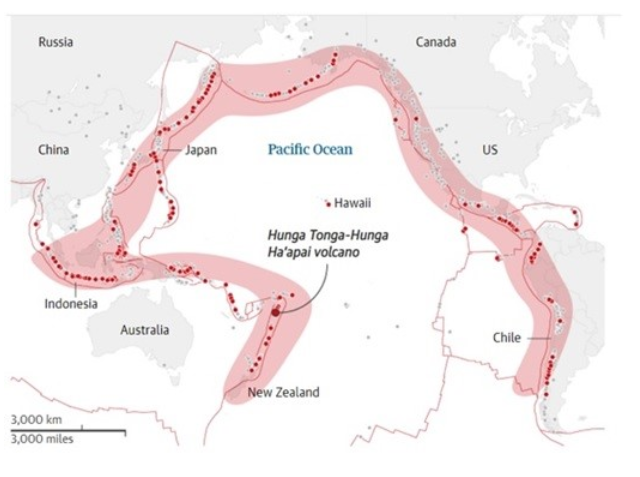 About Tonga
About Tonga
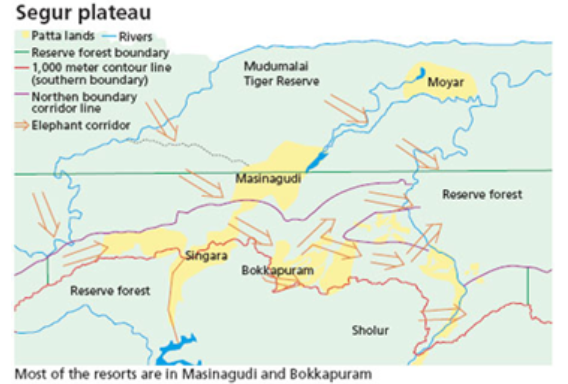
- Tonga is a group of more than 170 islands spread over an area of the South Pacific roughly the size of Japan, Tonga is the last Polynesian monarchy.
- Tonga is Characterised by tropical beaches, rainforest, and active volcanoes, it has a developing tourist industry
- Tonga has no strategic or mineral resources, and relies on agriculture and fishing.
India-Middle East-Europe Corridor: Catalyst to new world order
Exam View: About IMEC; Movement of Goods through IMEC; Significance of IMEC
Context: The signing of MoU for development of India-Middle East-Europe Corridor during G20 has been a landmark event. It has immense potential to put India, Middle East and Europe on collective path to growth, triggering regional and global cooperation
About India-Middle East-Europe Corridor (IMEC):
| Features | Description |
| Name | India-Middle East-Europe Corridor |
| Type | Multimodal trade and transit corridor |
| Objective | Promote trade and investment between India, the Middle East, and Europe |
| Route | The corridor will connect India to Europe through the Middle East. The exact route is still being finalised, but it is expected to pass through countries such as Iran, Turkey, Greece, and Bulgaria. |
| Modes of transport | The corridor will use a mix of road, rail, and sea modes of transportation. |
| Status | The corridor is still under development. However, a number of projects have been completed or are underway, such as construction of new roads & railways. |
| Key projects |
The Chabahar Port in Iran The International North-South Transport Corridor (INSTC) The Baku-Tbilisi-Ceyhan (BTC) pipeline |
Movement of Goods through IMEC:

- India to Arabian Gulf (Sea Route): IMEC links major ports of western India including JNPT, Kochi, Kandla and Mundra with major shipping ports of the Gulf, including Jebel Ali, Fujairah, Ras Al-Khair, Dammam, Duqm, and Salalah.
- Gulf ports to West Asian ports on the Mediterranean (Land Route): From these ports, cargo will be transported by the Saudi rail network on their north-south line to the port of Haifa in Israel through Jordan.
- Mediterranean Ports to European Ports (Sea Route): Haifa, being a deep seaport, can handle bulk container trains and carry cargo to European ports like Piraeus, Kavala (Greece), Trieste, La Spezia (Italy), Marseille-Fos (France), Barcelona, and Valencia (Spain).
- European Ports to hinterlands of Europe (Land Route): Road container trailers or container cargo trains will thereafter transport goods across Europe.
Significance of IMEC:
- Economic Benefits: IMEC is expected to boost trade and investment between India, the Middle East, and Europe, leading to economic growth and job creation.
- Reliable and Cost Effective transport solution: It envisions a reliable, cost-effective railway and ship-to-rail transit network to supplement maritime and road routes, enabling goods and services to move between India, the UAE, Saudi Arabia, Jordan, Israel and the EU.
- Reduce transportation time due to shorter routes as compared to Suez Channel route, making it more efficient to move goods and services between these regions.
- Development of Infrastructure: This proposed economic corridor project would help deal with the lack of infrastructure needed for growth in lower and middle-income nations
- Promotion of Intra-regional Connectivity: It will promote Intra-regional connectivity and enhance trade, prosperity and connectivity.
- Geopolitical Benefits: IMEC provides connectivity to accelerate the development and integration of Asia, the Arabian Gulf, and Europe as a new locus of global power.
- IMEC will also enhance India's strategic position in the region, giving it a greater say in global affairs.
- Reduction of dependence on Suez Canal, a major chokepoint in global trade.
- Counter to Chinese Belt and Road Initiative (BRI): India Middle East Europe Corridor (IMEC) is an ambitious counter to China’s BRI project.
- Geopolitical Stability in Middle East: This Corridor will help to bring countries in the Middle East together and establish that region as a hub for economic activity instead of as a “source of challenge, conflict or crisis”
- Environmental benefits:
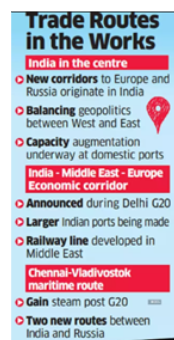
-
- Hydrogen Fuel pipelines: IMEC, envisages the laying of cables for electricity and a pipeline for transporting clean hydrogen. The greening of this project will contribute to the global effort to lower greenhouse gas emissions.
- Reduced fuel usage due to decreased travel time because of shorter routes and consequently lesser pollution.
Challenges for IMEC
- Non-binding MoU: The MoU of IMEC does not create any rights or obligations under international law, and is only a political commitment.
- Implementation challenges: Early implementation and construction of the corridor is a challenge due to the need to develop and commit to an action plan with relevant timetables.
- Financial Sourcing: The corridor would require massive finance for its construction, which is a challenge considering the recession and difficulty in mobilization of private sector finance.
- Chinese resistance: The corridor faces the challenge of Chinese pushback as China has already invested heavily in the BRI project and is making considerable investments in the Middle East.
Source: https://epaper.indianexpress.com/3764158/Delhi/September-19-2023#page/13/2
Share the article
Edukemy’s Current Affairs Quiz is published with multiple choice questions for UPSC exams
MCQ
Get Latest Updates on Offers, Event dates, and free Mentorship sessions.

Get in touch with our Expert Academic Counsellors 👋
FAQs
UPSC Daily Current Affairs focuses on learning current events on a daily basis. An aspirant needs to study regular and updated information about current events, news, and relevant topics that are important for UPSC aspirants. It covers national and international affairs, government policies, socio-economic issues, science and technology advancements, and more.
UPSC Daily Current Affairs provides aspirants with a concise and comprehensive overview of the latest happenings and developments across various fields. It helps aspirants stay updated with current affairs and provides them with valuable insights and analysis, which are essential for answering questions in the UPSC examinations. It enhances their knowledge, analytical skills, and ability to connect current affairs with the UPSC syllabus.
UPSC Daily Current Affairs covers a wide range of topics, including politics, economics, science and technology, environment, social issues, governance, international relations, and more. It offers news summaries, in-depth analyses, editorials, opinion pieces, and relevant study materials. It also provides practice questions and quizzes to help aspirants test their understanding of current affairs.
Edukemy's UPSC Daily Current Affairs can be accessed through:
- UPSC Daily Current Affairs can be accessed through Current Affairs tab at the top of the Main Page of Edukemy.
- Edukemy Mobile app: The Daily Current Affairs can also be access through Edukemy Mobile App.
- Social media: Follow Edukemy’s official social media accounts or pages that provide UPSC Daily Current Affairs updates, including Facebook, Twitter, or Telegram channels.



